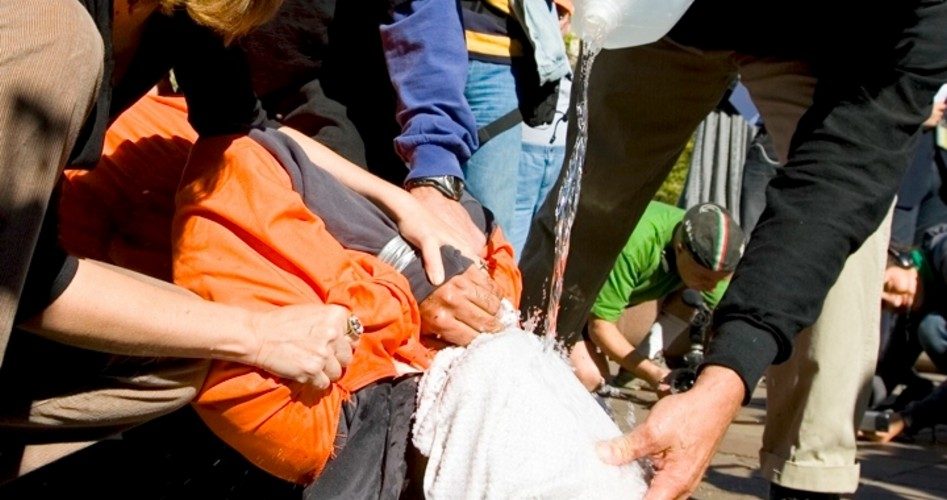
Informed sources say American journalist James Foley was waterboarded several times before being beheaded by his Islamic State captors, the Washington Post reported August 28. At least three other hostages held by the extremist group have also been subjected to waterboarding, said the sources, whom the Post identified only as “people familiar with the treatment of the kidnapped Westerners.”
Three other Americans are said to be held by the Islamic terrorists, including journalist Steven Sotloff. The extremists have threatened to kill Sotloff as well, in retaliation for U.S. air strikes against Islamic fighters in Iraq.
Waterboarding consists of tying the captive to a gurney or bench and pouring cold water over a cloth covering the face to create the sensation of drowning. “The wet cloth creates a barrier through which it is difficult — or in some cases not possible — to breathe,” said a Justice Department memo in May 2005 about the CIA’s use of the technique. Waterboarding was one of the “enhanced interrogation techniques” adopted by the CIA and sanctioned by the Justice Department when the agency opened a series of secret overseas prisons to question terrorism suspects after the September 11, 2001 terrorist attacks in New York and Washington, D.C. Three of the agency’s prisoners are known to have been waterboarded and one, self-declared 9/11 mastermind Khalid Sheik Mohammed, was waterboarded 183 times, according to a memo from the Justice Department’s Office of Legal Counsel.
“They knew exactly how it was done,” said a source who discussed the captors’ treatment of the hostages with the Post on the condition of anonymity The Islamic group, which has claimed the title Islamic State of Iraq and the Levant, “appeared to model the technique on the CIA’s use of waterboarding to interrogate suspected terrorists,” the Post report said, a claim hotly denied by an unnamed U.S. official quoted in the article.
“ISIL is a group that routinely crucifies and beheads people,” said the official. “To suggest that there is any correlation between ISIL’s brutality and past U.S. actions is ridiculous and feeds into their twisted propaganda.”
Five days after the 9/11 attacks, then-Vice President Dick Cheney said on NBC’s Meet the Press that the United States might have to work on the “dark side” in “the shadows of the intelligence world” to combat the terrorist threat. The Bush administration continually denied, however, that the waterboarding or other harsh techniques — including prolonged stress positions, exposure to cold and sleep deprivation — constituted torture. President Obama has reportedly banned the use of such methods and has condemned waterboarding as torture.”We did a whole lot of things that were right, but we tortured some folks,” Obama said in his August 1 news conference. We did some things that were contrary to our values.” He has steadfastly refused to prosecute officials responsible for resorting to torture in violation of both U.S. and international law.
“I understand why it happened,” the president said. “I think it’s important when we look back to recall how afraid people were after the Twin Towers fell and the Pentagon had been hit and the plane in Pennsylvania had fallen, and people did not know whether more attacks were imminent, and there was enormous pressure on our law enforcement and our national security teams to try to deal with this. And it’s important for us not to feel too sanctimonious in retrospect about the tough job that those folks had. And a lot of those folks were working hard under enormous pressure and are real patriots.”
Yet the interrogation methods, as well as the “extraordinary rendition” of terror suspects to other countries to be interrogated by governments known for their use of torture, continued well beyond the immediate aftermath of the 9/11 attacks. The abuses of prisoners at the Abu Ghraib prison in Iraq went on until they came to light some two-and-a-half years after 9/11. President Bush did not close the CIA’s overseas prisons until 2006. A yet-to-be-published Senate report on the CIA’s interrogation methods led to the hacking by CIA personnel of computers used by the Senate panel, something CIA Director John Brennan initially denied in testimony to a congressional committee before later admitting it had occurred. So far no charges against or investigation of the CIA chief have been launched over his giving false testimony under oath.
Critics of U.S. policy have charged that the overthrow of Saddam’s decades old secular regime by the United States and its allies in 2003, and of the Gadhafi government in Libya in 2011, has created a power vacuum that jihadists have arisen to fill following the U.S. withdrawal from Iraq. ISIL fighters have captured significant territory in Iraq and threaten the survival of the government headed by Prime Minister Nouri al-Maliki, which remains shaky despite a series of parliamentary elections and years of military and economic support from the United States. The jihadists are also among the insurgents receiving logistical and diplomatic support from the United States in the fight to overthrow the dictatorship of Bashar al-Assad of Syria. Now the U.S. faces the prospect of supporting Assad in an effort to defeat ISIL.
Critics of waterboarding and other interrogation methods employed by the CIA have often argued that the use of such techniques will increase the likelihood of their being used against Americans taken hostage in overseas conflicts. Reports of waterboarding of U.S. captives in Syria and/Iraq may be the sad news of the “chickens coming home to roost.”
Photo shows protestors demonstrating a waterboarding in front of the U.S. Justice Department on Nov. 5, 2007: AP Images


